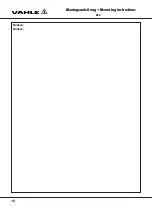
KBH
8
Montageanleitung
앫
Mounting instructions
Führen Sie die Kupferschienenenden
in die Schraubverbinder einzeln etwa
5-10 mm ein (
G18
).
Drücken Sie die beiden Gehäuse
soweit zusammen bis eine mechani-
sche Verbindung entsteht (
G19
).
S
Achtung!
Elektrische Verbindung
Die Schraubverbinder müssen
vollständig einrasten, um die
notwendige elektrische Verbin-
dung zu gewährleisten.
H
Prüfen Sie durch Auseinander-
ziehen und Zusammenschieben
des Gehäuses den Kupferschie-
nenstoß. Die Verriegelungs–
nasen der Verbinder müssen
eingerastet sein (
G20
).
Lösen Sie die Kontermuttern (
1
) (
G21
).
Ziehen Sie die Gewindestifte (
2
) mit
einem 3 mm Sechskantschlüssel mit
1,5 - 2 Nm an (
G21
).
Kontern Sie die Muttern (
1
) mit 5 Nm
(
G21
).
S
Achtung!
Die Gewindestifte mit
max.
2 Nm
anziehen, damit der
Bügel des Schraubverbinders
nicht deformiert wird.
S
Prüfen Sie den Übergang der
Kupferschienenstöße durch
Sicht und Tastkontrolle. Der
Übergang muss glatt und
bündig sowie ohne Grat sein,
um eine Beschädigung der
Schleifkohlen des Stromabneh-
mers zu vermeiden. Ein Abstand
der Kupferschienen bis 2 mm
zueinander ist normal.
Setzen Sie den Stromabnehmer ein
(s. Seite 15) und fahren Sie ihn durch
den Bereich, um Unregelmäßigkeiten
festzustellen.
Gehäuseverbindungen bei
KBHF und KBHS
Setzen Sie die Stoßabdeckkappen
von unten mittig auf die Verbindungs-
stelle (
G22
).
H
Die Noppen (
1
) der Kappen müs-
sen in die Langlöcher (
2
) des
Schleifleitungsprofils einrasten
(
G22
). Die U-förmigen Umgreifun-
gen der Stoßabdeckkappen (
4
)
müssen an den unteren Stegen
der Schleifleitung einrasten (
G 23
).
1
2
G19
G21
1
2
G22
Individually and partially insert the ends
of the copper conductors into the
bolted joints by approx. 5-10 mm (
G18
).
Compress the two housings until a
mechanical connection is formed
(
G19
).
S
Caution!
Electrical Connection
The bolted joints need to snap
in completely to secure the ne-
cessary electrical connection.
H
Check the copper conductor
joint by pulling and pushing
both sections of the housing.
The locking lugs of the connec-
tors must be engaged.
Loosen the counter nuts (
1
) (
G21
).
Tighten the setscrews (
2
) to 1.5-2 Nm
using a 3-mm wrench (
G21
).
Fix the counter (
1
) with 5 Nm (
G21
).
S
Caution!
Tighten the setscrews with
max. 2 Nm
to avoid deforming
the clip of the bolted joint.
S
Check the transfer of the
copper conductor joints visu-
ally and manually. The transfer
must be smooth and flush and
without burrs to prevent any
damage to the carbon brushes
of the collector. A distance of
the copper conductors up to
2 mm is normal.
Insert the current collector (see page
15) and pull it through the joint area to
detect possible irregularities.
Joint covers for KBHF and
KBHS
Position the joint caps at the center of
the joint from the bottom (
G22
).
H
The maps (
1
) of the caps must
engage in the slotted holes (
2
)
of the powerail profile (
G22
).
The U-shaped webs of the
joint caps (
4
) must engage into
the lower lips of the powerail
(
G 23
).
5-10 mm
G17
G18
G20




















